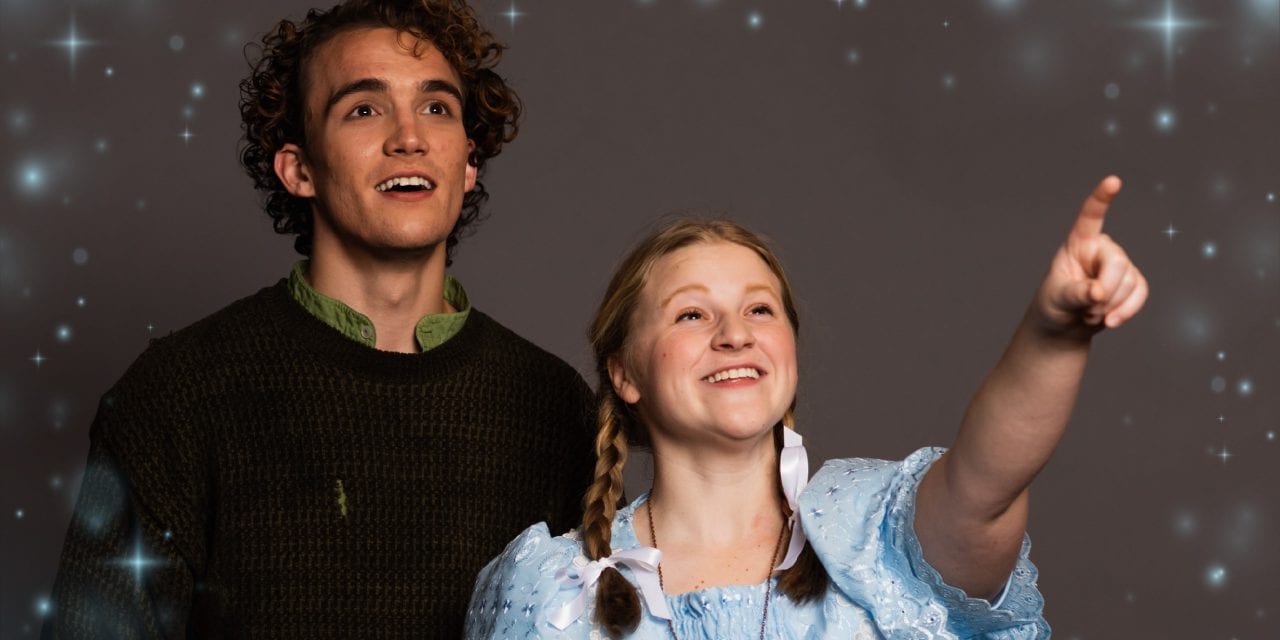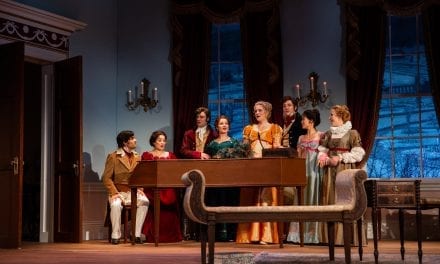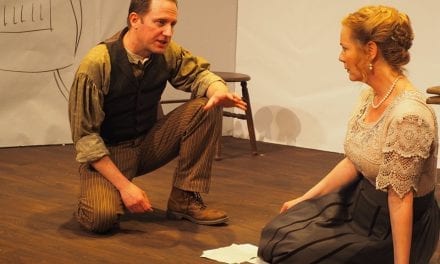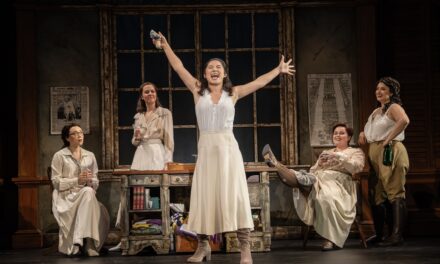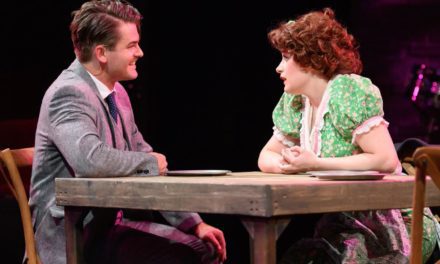CENTERVILLE — Peter and the Starcatcher is the origin story of Peter Pan and the magic of Neverland. The play unfolds the transformation of an orphan known simply as The Boy into the confident hero that will later lead the Lost Boys. Along the way we meet the young starcatcher Molly Aster who will become Wendy’s mother, and the pirate captain Black Stache who re-brands as Captain Hook. Basing the work on the book by Dave Barry and Ridley Pearson, Rick Elice wrote a play with music by Wayne Barker that is a magical, plucky, quirky, thoughtful, and sweet story. Centerpoint Legacy Theatre’s production hit all of those notes, despite a rocky start.

Show closes February 15, 2020.
One large challenge of staging the play is to manage the huge amount of exposition where the actors are talking to the audience, especially in the beginning. I was hopelessly lost as the play opened for several reasons, the largest being that the sound equipment seemed off. At the same time as the fast-paced dialogue, the actors where also swarming the stage, crisscrossing to different parts of the set. While the activity fit with the story, two ships about to depart, it also added a significant bit of background noise and distracting activity. My eye wasn’t sure where to go, especially because the set was so interesting. Unfortunately, because my ear couldn’t follow either, keeping up with the story and connecting with the characters was initially difficult. Bill Slank, played by Jake Omer, was especially difficult to understand, whether because of his mic or his enunciation. Still, his sliminess was captivating, and the sound improved as the performance continued.
The set design by Bryan Christensen delighted me throughout the production. It was a treat to see how the actors would utilize it or transform it from scene to scene. The set had its own choreography that the cast and crew managed seamlessly. Wonderfully using all of the height and width of the CenterPoint stage, the design anchored the setting while still leaving plenty to the imagination. The set was playful and reminded me of a giant fort but also had the versatility to be a sinister dungeon. My favorite transformation was when the two bows of the ships rotated and converged to become a boxing ring in the center of the stage. Combined with the lighting, a mic dropping from the ceiling and wonderful acting, the transformation made for a memorable scene.
Similarly, the lighting design by William Peterson was a major player in the magic of the production. Some of my favorite moments were when Peter met the mermaid in the Grotto and during the enchanting slow-motion scene. From grimy ship, to starlit ocean, to tropical jungle and more, the lighting design was brilliant.

Left to right: Stone Newbould as Ted, Skylar Smith as Prentiss, and Jason Shumate as The Boy. Photo by Pepperfox Photo.
In contrast to the chaotic opening of the first act, the opening song and choreography to the second act was just the right pace. Captain Black Stache, played by Brandon Green, stuck his hand out from behind a shimmery curtain dressed as a mermaid and began to sing. He was then joined by a whole ensemble of crusty sailors wearing mermaid costumes. The simple choreography in this scene perfectly allowed each of the actors to add their personality. Mack, played by Kat Omer, particularly stood out in this number, even before her solo. I wanted her to keep singing.
For a show with just a little dancing, there was a lot to choreograph. Director and choreographer Liz Christensen masterfully controlled the pace of the show by composing high-paced scenes that had significant movement both in actors and in set and then by contrasting those scenes with focused and deliberate, heartfelt moments. One of my favorite choreographed sections was when the cast mimed the doors and rooms of the different parts of the belly of the ship. It was so sharp and creative. With the excellent light and sound design, the whole effect was pretty magical.
The chemistry on the CenterPoint stage was abundant. The three orphans, Jason Shumate playing The Boy/Peter, Skylar Smith playing Prentiss, and Stone Newbould playing Ted, complimented each other’s performance throughout. Newbould had excellent comedic timing, especially when shouting “Pork!” The chemistry between Lord Aster, played by Jeremy Jonsson, and his daughter Molly, played by Emma Kate Leishman, was warm. Surprisingly, their chemistry was strongest when they were speaking some bird dialect. The best chemistry of the night was appropriately between Peter and Molly. Shumate and Leishman developed their characters’ relationship at different levels throughout the play. From when Molly first met The Boy to when they said a tearful goodbye, there were many solid interactions that pulled me into their story and their characters. Some examples include The Boy’s poignant explanation about why “sorry” doesn’t cut it, when the two argue over who is the boss, and when Molly has to decide to save the starstuff or rescue Peter. The romantic moments were especially sweet and sincere and elevated the quality of the show tremendously.
I was particularly impressed with Leishman’s range. She exuded confidence. She played bold, strong, and tender equally well. Leishman had a velvety voice that could always be heard and understood. And she was hilarious. When Molly was translating “Norse Code” for the boys, Leishman had the speed, articulation, and pace to pull the most from the exchange.
Another favorite of the night was the pirate captain Black Stache played by Green. Green had a dexterous tongue that enabled him to project, articulate, and be understood—even when Stache would humorously mispronounce words. There were so many well-constructed physical comedic bits as well—from throwing up into a bucket, to the boxing match with Slank, to singing and dancing as a mermaid, to when he cut off his own hand in the trunk. Green brought a level of sophistication to Black Stache as well. When Stache discerned the heroism in Peter, Green brought an earnestness to Stache’s villainy.
Green was well-supported by Oran Marc de Baritault‘s characterization of Smee. I liked that Baritault gave Smee more maturity and less bumbling stupidity while still supporting Stache’s leadership. The two actors played off each other well, adding much humor and humanity to their scenes.
Logan Stacey’s Mrs. Bumbrake was a little hit and miss. I loved Stacey’s commitment in playing Mrs. Bumbrake. His energy and his interpretation were enjoyable. Most of the misses had to do with the sound in the theatre. I had too much difficulty understanding his words at various points during the show and just couldn’t follow all the alliterative jokes.
In the modern social climate, the part of the play that is the most difficult to stage are the scenes with the Mollusk tribe. The racism via reductionism that is apparent in the portrayal of the native people in Peter Pan was something playwright Elice was familiar with. His answer to this problem was to change the native tribe to Italian and throw in many pasta jokes. While the pasta jokes remain in CenterPoint’s production, the costuming invokes Polynesia. Combined with inconsistent accents among the tribe members, the scene were more confusing than anything else.
Overall, I had an enjoyable evening with my son because of the solid acting and impressive technical theater. As we both enjoy word play, and as this production is a word-heavy show, he and I thoroughly enjoyed the dialogue and jokes when we could hear them. I would recommend this show only to children that appreciate a quick wit and can keep up with its verbal speed. This production could also be difficult for someone hard of hearing, although there is so much life, energy, and sparkle on the stage that often the visuals must speak for themselves.

